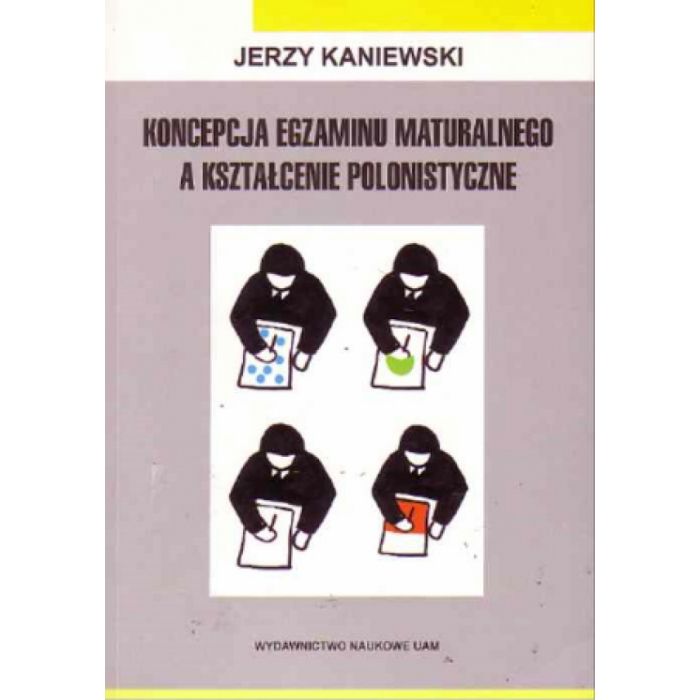Koncepcja egzaminu maturalnego a kształcenie polonistyczne, Konstrukcja tematów i kryteria oceniania prac pisemnych na tzw. nowej maturze
- Dostępność: dostępny
- ISBN: 978-83-232177-5-6
- Kategoria: OUTLET, Filologia Polska
- Data wydania: 2007
The book is centred around problems connected with the new matura examination in Polish introduced in 2002. The author is interested most of all in the written part of the examination paper, especially in the perspective of the manner of representation of the knowledge of Polish in the matura tasks and reliability of the criteria-based evaluation of the matura paper (usefulness of tools applied for measuring achievements in the field of Polish studies). The author tries to answer the question: Which model of education in the field of Polish is generated by the new form of the examination and in what way the solutions applied during the examination may influence educational practice. To a great degree, this work is based on the analysis of empirical material (ca. 1000 matura papers written by pupils in 2002 and 2005). On the basis of analyses performed the author formulates an evaluation of the conception of the examination and proposes a scope (number) of indispensable changes which should be introduced.
- ROZDZIAŁ I
- MIEJSCE EGZAMINU MATURALNEGO W EDUKACJI SZKOLNEJ
- 1. Matura w systemie edukacyjnym
- 2. W poszukiwaniu formuł tematycznych
- 2.1. Egzamin pisemny - wymagania
- 2.2. Temat wobec kontekstów
- 3. Wymagania egzaminacyjne a wymagania edukacyjne
- 3.1. Wobec ideologii
- 3.2. Pytania o wiedzę i umiejętności
- 3.3. Kryteria oceniania
- 4. Tematy po 1991 roku
- 5. Kryteria raz jeszcze
- 6. Wnioski
-
- ROZDZIAŁ II
- NOWA MATURA - DIAGNOZY I PROGNOZY
- 1. Matura 2002 - koncepcja tematów, prezentacja wyników
- 1.1. Koncepcja tematów -poziom podstawowy
- 1.2. Wyniki arkusza I (wypracowanie na poziomie podstawowym}
- 1.2.1. Analiza wyników - temat l
- 1.2.2. Analiza wyników - temat 2
- 1.2.3. Wnioski
- 1.3. Wyniki arkusza III (wypracowanie na poziomie rozszerzonym)
- 1.3.1. Charakterystyka zadań
- 1.3.2. Analiza wyników arkusza
- 1.3.3. Wnioski: umiejętności maturzystów na poziomie rozszerzonym
- 1.4. Ocena wyników matury 2002
- 1.4.1. Sprawność językowa i umiejętności tekstotwórcze
- 1.4.2. Ocena matury 2002
- 1.5. Między rokiem 2002 a 2005
- 2. Matura 2005 - kontynuacja czy "nowe otwarcie"?
- 2.1.Prezentacja wyników ogólnych
- 2.2. Wyniki arkusza I (poziom podstawowy)
- 2.3. Wyniki arkusza II (poziom rozszerzony)
- 3. Wnioski z egzaminu przeprowadzonego w 2002 i 2005 roku
-
- 1. Matura 2002 - koncepcja tematów, prezentacja wyników
- ROZDZIAŁ III
- MATURALNE RE - WIZJE
- 1. Wokół instrumentarium pomiarowego
- 1.1. Nowomaturalne kontrowersje
- 1.1.1. Egzamin ustny
- 1.1.2. Egzamin pisemny
- 1.2. W poszukiwaniu kryteriów maturalnych
- 1.2.1. Prezentacja i ocena rozwiązań alternatywnych
- 1.2.2.Teoretyczne aspekty konstruowania kryteriów
- 1.2.3. Propozycja siatki oceniania wypowiedzi interpretacyjnej
- 1.1. Nowomaturalne kontrowersje
- 2. Polonistyczne standardy wobec zasady reprezentatywności treści przedmiotowych na maturze
- 3. Kanon a przestrzeń kulturowa ucznia
- 3.1. Spory o kanon
- 3.2. Kanon a tożsamość
- 3.3. Kanon a edukacja
- 3.3.1. Kanon w szkole
- 3.3.2. Jaki kanon?
-
- 1. Wokół instrumentarium pomiarowego
- Zakończenie
- Aneks
- Indeks nazwisk
-
- Conception of the matura examination and education in the field of Polish Construction of topics and assessment criteria of written papers of the so called new matura (Sumrnary)
| Informacje szczegółowe | |
|---|---|
| Wersja publikacji | drukowana |
| Format | 17,0 x 24,0 |
| Tytuł (EN) | Conception of the matura examination and education in the field of Polish. Construction of topics and assessment criteria of written papers of the so called new matura |
| Typ publikacji | Monografia |
| Wydanie | I |
| Seria | Filologia Polska nr 99 |
| ISSN | 0554-8179 |
| ISBN | 978-83-232177-5-6 |
| Liczba stron | 352 |
| Liczba arkuszy wydawniczych | 26,00 |
| Rodzaj oprawy | miękka |
